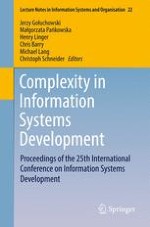This volume is a collection of papers on emerging concepts, approaches and ideas in information systems research. It examines theoretical and methodological issues related to both information systems development in general and the complexity of information systems as socio-technical systems.
The book draws on invited papers selected from the proceedings of the 25th International Conference on Information Systems Development (ISD) held in Katowice, Poland, August 24 - 26, 2016. The invited conference papers were revised and expanded and present research that is focused on context, creativity, and cognition in information systems development. These issues are significant as they provide the basis for organizations to identify new markets, support innovative technology deployment, and enable mobile applications to detect, sense, interpret, and respond to the environment.
